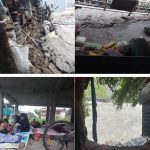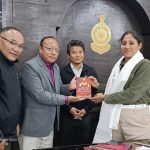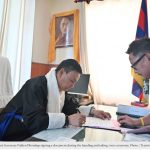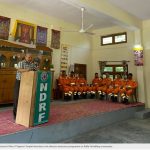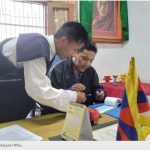DHARAMSHALA: CTA President Dr Lobsang Sangay spoke to ‘India Ahead’s Ridhima Bhatnagar in a 20-minute interview on the ongoing border clashes between India and China, sharing his expert knowledge as a Tibetan scholar and democratically-elected political leader of the Tibetan community, on the lessons India could draw from Tibet’s experience with China.
The latest interview is among a series of others the CTA President has given in the period between lockdown and the clashes at the LAC, successfully highlighting the core issue of Tibet which needs to be resolved for peace to be restored between two of the largest countries of the world.
Ridhima Bhatnagar: We have been discussing for almost weeks now, it is the bloodiest clash that we have seen between the two nations in almost 4 decades. Now, de-escalation talks are still on between the two nations but what really has changed after the Galwan clash which resulted in India losing 20 of its Bravehearts. What should India’s strategy be? To discuss this, I have with me a very special guest joining me today on this broadcast. We have Dr Lobsang Sangay who is Tibet’s Prime Minister in exile. Dr Sangay, it’s a pleasure having you in ‘India Ahead’ and for you to have your inputs to give us on this topic for us to understand what should the learning lessons for India be from Tibet and what should the way ahead really be. Now before I get into the nitty-gritty of what the strategy should really be? What can the learning lessons from Tibet be? I want to first begin with your sense of understanding of the current phase of, between India and China because it is very very similar to what happened to Tibet.
CTA President Dr Lobsang Sangay: Yes, first I want to say hello to you and to all the listeners. It’s a tragedy that 20 brave Jawans have been killed and our condolences go out to their family members. Now, as far as Tibetans are concerned, we have been saying this for the last 60 years that China came in the name of peace and prosperity for the Tibetan people, ultimately almost everything that they promised us were betrayed and at the end, we lost our nation and people are suppressed and suffering. So whenever you deal with the Chinese government, you must verify, verify, then only trust. So in the case of recent incidents, you can clearly see the de-escalation talk was on, Line of Actual Control was demarcated but having made all these promises, ultimately, it led to violence and death of so many soldiers, which is really tragic and unfortunate.
Ridhima Bhatnagar: Dr Sangay, as you rightly pointed out that there is a sense of betrayal that of course, the Indian side has now seen because talks of de-escalation as per the usual agreement was only India that held on its agreement barter and said that we will escalate, but when the Indian side realised that the Chinese had not escalated, they went ahead for talks and that’s what led to the clash at the Galwan valley which resulted in India losing 20 of its Bravehearts. But despite all of that there is never an acceptance from China’s side that there was no de-escalation, ironically, there was a counter allegation on India that it was actually India who moved into the Chinese territory and that’s what led into the Galwan clash. Has this been similar learning or sense of Deja Vu for you, when you saw what happened with Tibet as well?
CTA President Dr. Lobsang Sangay: Yes, for the last 60 years, even today, the Chinese government claims that Tibet was peacefully liberated, when approximately a million Tibetans died after the occupation of Tibet. Even today, they say that Tibetans are happy and content, so they follow the Chinese leadership when in fact, 154 Tibetans have committed self-immolation. Now, they always say this that Coronavirus is not their’s but Ladakh is theirs, Tibet is theirs, Taiwan is theirs, Hong Kong is theirs, Arunachal is theirs, all these things are theirs but except for Coronavirus. The whole world knows that Coronavirus is theirs. So in broad daylight, they are capable of saying such things. So this is what happened at the border, it’s symptomatic of the larger picture.
Ridhima Bhatnagar: Dr Sangay, before I get into what really is making China so jittery and what’s happening with India’s other neighbours, I want to understand from you in a very broad perspective when we have seen this betrayal of de-escalation from China, do you think then Tibet becomes a very important component to the resolution in the broader picture?
CTA President Dr Lobsang Sangay: Yes, because if you look at the map of China, the Han-Chinese occupied territory was only 40% and in fact, they believed the ‘great walls’ prevent barbarians and enemies from entering, that was there wall. Now, they have gone beyond the great wall and occupied Mongolia, Manchuria, Xinjiang, Tibet. So if you look at the map of China, 60% of the territory was occupied militarily, now, after occupying Tibet, they said, Tibet is the palm, you have to go after the 5 fingers, Ladakh, Arunachal, Sikkim, Bhutan and Nepal are the 5 fingers. So this has been their strategy, we have been saying this, ‘what happened to us, could happen to you’. Now, it’s happening in India so historically, it was a demilitarized zone, it was a zone of peace and demilitarised border, it was a peaceful border. Since the India-Tibet border changed to the China-India border, even the media calls it the India-China border nowadays. It still remains the India-Tibet border, since then all this tension happened and it will continue to happen till you address the issue of Tibet, to make Tibet a zone of peace, to restore the status of Tibet as the buffer zone between China and India.
Ridhima Bhatnagar: Dr Sangay, I will get to that as well but I just want to take on from something that you said earlier, do you think China is already in a very jittery and nervous position because you already have the pandemic that started from Wuhan which was the epicentre, and then moved on to various other countries so there is already a lot of pressure on China for probably first, for not letting the global community know in time, then not revealing the correct numbers and even today, probably the recurrence that we have seen, the second wave that we have seen, we are probably not getting the true numbers out of it so already China was in a vulnerable position and that is probably why you are seeing a sense of agitation in China today.
CTA President Dr Lobsang Sangay: Yes, on the one hand, China has a long term strategy, expansionist policy, occupied Tibet, and come after 5 fingers. On the other hand, externally China’s facing tremendous pressure, WHO which normally leans towards China, some of the officials have decided to investigate the origin of the virus and 130 countries have decided to do it and objective analysis will be done and in fact, there could be a punishment. Now, at a larger scale, globally, the Coronavirus pandemic has caused enormous economic pain, enormous social pain, and health crises all over the world, and who is to be blamed?! China tried to hide the information for 3 to 6 weeks which caused the whole world a huge price. Had they told us ahead of time, some experts say 95% of the infections and death could be prevented. Internally, now there are criticisms within Chinese leadership because of lack of freedom of speech, lack of democracy, lack of human rights that you can clearly see in Tibet. Nowadays, just recently, they introduced a regulation saying that a monk to move away out of the monastery, you need permission, from one district to another, you need permission. So there is a complete clampdown on Tibetans and Uyghurs and others, what it shows, is there a paranoia within because of external pressure.
Ridhima Bhatnagar: And already, it is the holy month which allows the movement of monks as well, but you are still seeing this sort of pressure that you are seeing from China.
CTA President Dr Lobsang Sangay: This is the holiest month when pilgrims were supposed to go for pilgrimage and people are supposed to visit monasteries and do all kinds of prayers. Now, monks are supposed to go out and pray for the wellbeing of sentient beings, and Tibet in particular. All these things are restricted if you are a Communist party member. Once you retire, you are banned from going to any monastery or practice any spiritual matters. Can you imagine you are banned for life?! This is how much insecurity and paranoia are there, so there is a complete clampdown. Hence, 154 Tibetans have committed self-immolation, burn themselves, protesting against the Chinese government.
Ridhima Bhatnagar: Dr Sangay, I want to now talk about something you touched upon earlier which is the expansionist policies from China that seem to be on a rise now. Take the example of Nepal, you already had Nepal putting out, a new map, there are anti-India songs that are being played in Nepal and it is said that the whole subcontinent has been on the radar of the Chinese leaders since almost 1960s. Do you think this desire of the expansionist policy is on a much heavy, rising than it was before?
CTA President Dr Lobsang Sangay: Yes, that’s what we have been saying, you have to study Tibet to understand China’s mindset and India can learn lessons, for example, one road was built connecting China to Tibet to bring prosperity but it brought tanks, guns in trucks, Tibet was occupied. Now, that one road has become 100 roads and some of the roads are connecting all the way to the border of India, Arunachal and Nepal and Bhutan too. Right now, the railway line is coming all the way from China to Tibet, to the border of Nepal and they want to connect it all the way to Lumbini, that’s the border of Uttar Pradesh. And 30 airports are there in Tibet, of which 6 are military airfields and bordering India and Nepal as well. All this military build-up that took place, that continues to take place, will connect to all the border areas of India, including Bhutan, Nepal, Arunachal Pradesh and Ladakh. So this is what’s happening. So Nepal is under tremendous pressure so there are more Chinese in Nepal than Tibetans in Nepal now, this is the equation now. Because of Chinese pressure, Tibetans are also a bit under stress.
Ridhima Bhatnagar: Clearly, we can see the expansionist plans, in terms of China trying to accomplish its 5 finger plan. But I want to in specific, Dr Sangay, understand it from you since you have understood not only the situation of Tibet, you understand the mindset of China as well a lot better than many of us understand. But what is your understanding of what’s happening on the LAC because for India for the longest time, the LOC has been the priority in terms of Pakistan. Somewhat, sometimes, the LAC takes a backseat but today once again, this has become the headlines. What is your understanding of what’s really happening on LAC despite all these talks of de-escalation that is still happening at the diplomatic level as well as the military level between both the nations?
CTA President Dr Lobsang Sangay: I think we should remember, the late George Fernandes ji, who when he was the Defence Minister said look, it’s not LOC, LAC is the challenge, China is the number one adversary of India, he said that on the record. At that time, he was criticised a lot, now all the facts are true that he was right. Now, that is at the individual level, even in the US and Europe, discourse went around, should we cooperate with China or should we compete with China. After 30 years, there is a consensus in Washington DC that China is a competition and less of a cooperator. Europe recently has decided that China is a competition and less of a comparator, so India has to go through the same thing. Is it, should we compete more or should we cooperate more? And LOC/LAC same thing, as I have said, this will continue, pressure in Nepal, pressure in Ladakh and Galwan valley is the same valley through which the Chinese army entered in 1962. Now 2 things are very important, this year marks the 70th anniversary of diplomatic relationship between China and India. And in Tamil Nadu where Prime Minister Modi ji met with Xi Jinping in October, they said we will celebrate this year in a grand way, we will have 70 events to mark 70th anniversary. Essentially, 70 years ago, China let go of Taiwan and recognised China and then India helped China become a member of the UN Security Council. Instead of celebration, incursions and violence and tragedy has happened, so on the one hand, they were extending their hand of friendship, that’s the talk, on the other hand, they were preparing for the intrusion in Galway valley.
Ridhima Bhatnagar: That’s something I have spoken to a lot of experts about. I know exactly what you are saying that the timing as well was very notorious on the part of China, but now I want to understand what can India do from here on. A lot of foreign counterparts have stepped in and given their commentary as well. You obviously, have Donald Trump saying that we would want to help both the nations, something that he has done in the past as well. Both the nations maintaining that we would like to solve this bilaterally, you had a comment coming in from the United Kingdom’s Boris Johnson as well. Do you think it’s the right time for India to probably see some sort of refuge with the United States because that’s going to play a larger role tomorrow when these bilateral ties between India and China rebooted?
CTA President Dr Lobsang Sangay: Practically and ideologically. Practically, India is going to be chairman of the WHO that’s when the investigation of the Wuhan-virus is going to take place. So India has a say as to how to shape the investigation of the Wuhan-virus. Obviously, it originated in China and China should be blamed for it. Ideologically, you must form an alliance of democracies, America is a democracy, European countries are democracy, UK, Japan, Australia. This is a challenge of ideology, authoritarian system, or democratic system, and is the Xi Jinping thought or human rights as basic freedom, this is the challenge. Ideologically, India should be on the right side of India’s path which is democracy. Everybody accepts that India is the largest democracy in the whole world and India should not only participate, should take the lead in saying, democracy is what we support and democracy should be there in China as well and international norms and regulations should be followed by everybody, including China. That’s how you push back, there has to be coordination among like-minded countries.
Ridhima Bhatnagar: Dr Sangay, I want to understand, taking on from what you said, I want to understand in 2 parts. One, I want to understand, this is a huge clamour going in India that is talking about the whole boycott of the Chinese goods, you had domestic makers saying that this is probably an opportune time to hurt China economically more than what we can do on the military level. That is the first part of my question, do you really think that the way forward in terms of hurting it economically, not in terms of a kneejerk reaction but in terms of a longer perspective. My other part of the question is, what is realistically possible on the issue of Tibet as well because the justification that has come from China, time and again, is a sense of economic justification similar to what we hear for India as well.
CTA President Dr Lobsang Sangay: Now as far as the boycott is concerned, there is a lot of talk going on. Now, first of all, instead of boycotting something, I think you can buy more of Indian manufactured goods because of the coronavirus, the economy of India is affected severely, 100 million migrant workers are unemployed now, agriculture, everything is affected and this is the time to buy India’s product and supply India’s good, this is a logical thing to do. You don’t have to boycott something, you buy more of India. “Make in India” campaign by Modi ji should be supported by all the Indian companies. I have been saying this, celebrities should endorse India’s products, then the Indian people will buy more. At this time, when there is tremendous pressure on employment and economy if celebrities keep endorsing Chinese products then the fans and the followers will be led to buy more of the product. There are a lot of things you can do in India. Secondly, the issue of Tibet, India should recognise that Tibet is very important, geopolitically we are talking, culturally, spiritually very connected and hence we need to educate the Indian masses about Tibet. Galwan valley incident happened, suddenly there is interest in Tibet, at the university level, how many departments are there on Tibet studies programmes, think tanks, researchers are there. If you go to Harvard, or Yale or Cornell, many major universities in America or Europe, there are so many Tibetan studies programmes, there are so many Tibetans who are experts in this field. So if you want to really address this issue, you need to educate Indian people, at least the intellectuals, think tanks, universities about Tibet and bring Tibet as the core issue. China says let’s solve this border issue, India should say, let’s do it. Tibet should be the zone of peace, Tibet should be the buffer zone, Tibetan people deserve their basic human rights because largest number of Tibetans are in India and for all these historical, cultural, spiritual reasons, we need to support the people of Tibet.
Ridhima Bhatnagar: Interesting that you say that, Dr Sangay. So diplomatically if I had to ask you what can be the learning for India? Because diplomatic talks are still on. Can India really learn from what Tibet went through? Because if you look at the Shimla convention of 1940, the terms border of Tibet finds mention in it, but after it was renewed between Beijing and India, India actually had to withdraw some of its personal, and that later resulted in the war of 1962. So that really didn’t play well for India as well so do you think those are lessons from what happened with Tibet and India earlier as well for India now to pay deeper attention to the lessons it can now learn from both these parties.
CTA President Dr. Lobsang Sangay: Yes, I think from 1940 on, the Simla convention of 1914 between India and Tibet, the Chinese objection was the border between Tibet and China. They didn’t object to the demarcation between India and Tibet. Essentially, they accepted it but ultimately they didn’t sign the document mainly because they disagreed with the border between Tibet and China. But then, it was supposed to be renewed every 10 years, in 1924, in 1934, in 1944 after it was renewed between Tibet and India, India later renewed it with China, and then they came back with Panchsheel. If you look at the body of the document, its all trade but if you look at the preamble, they put 5 points and say Panchsheel. In the document itself, the betrayal is there because the Panchsheel was supposed to last for 25 years as per India’s wishes, but China wanted it to last for 5 years and later then negotiated, it lasted for 8 years. In 5 years, 54+5, in 1959, Tibet was occupied and 1954+8 years, 1962, invasion of India happened. So the Panchsheel, the document for trade and tranquillity was essentially treachery and tragedy, and the tension prevails even now. You can learn lots of lessons even with these documents.
Ridhima Bhatnagar: Dr Sangay, before I wrap up, I want to shift a little bit and I also want to understand, you see a close relationship with His Holiness the Dalai Lama himself, you know you have also become the official spokesperson for him. Have you had a chance to talk to him about the situation and any sort of reaction that has come from the Dalai Lama himself?
CTA President Dr Lobsang Sangay: His Holiness is incomplete retreat now, given the pandemic and he is isolated. Normally, I would get an audience with His Holiness every month, sometimes a few times a month as well. So because I am more exposed to the public so there is a bigger chance of me being infected so I have not sought any audience but he has been in the public at least online, giving spiritual teachings and all that. So he is doing very well, he calls himself the proud son of India, he talks about India everywhere in the whole world. He loves India, Indian tradition, Nalanda tradition, secularism, all that. So you have the best person as far as India is concerned, so obviously, he is very sympathetic to what’s happening with India but now I am given the political responsibilities since 2011, we have complete separation of Church and State. So I am doing my part because this is a political matter so I am doing the best I can to represent the views of the Tibetan people as a whole.
Ridhima Bhatnagar: Sure. Dr Sangay, lastly before I let you go so now that we understood the lessons that probably India can receive from Tibet and understanding the mindset of China is extremely important right now, what should be the way ahead for India now?
CTA President Dr Lobsang Sangay: Yes, there must be de-escalation at the border and there must be talks to solve this but also should learn that incursions have increased from 2012 till now to 200, 300 and 400. The standoff in 2017 to standoff in Ladakh, several incursions and the violence that took place, should learn that it might continue, not just continue, it might escalate. So be very prepared, be very cautious and verify, verify, verify, then only trust.
Ridhima Bhatnagar: I think its a very, very important message that you are sending out, Dr Sangay which is verified, understands the mindset and takes lessons from Tibet as well. Its been a pleasure chatting with you, Dr Sangay. Thank you so much for taking out time and talking to us here at ‘India Ahead’




